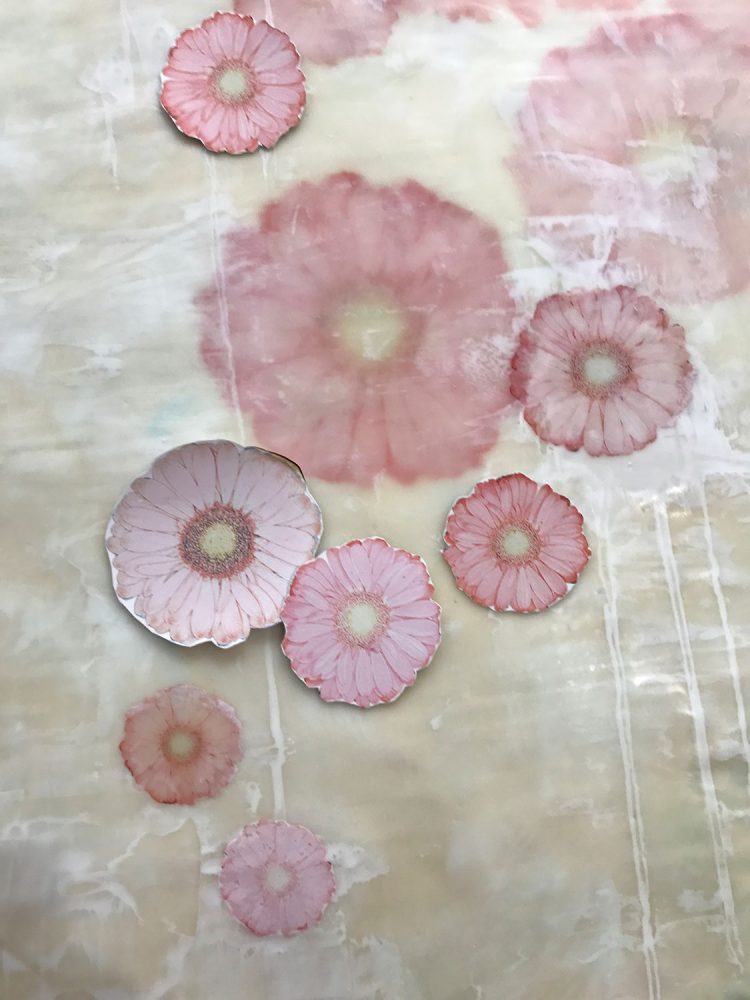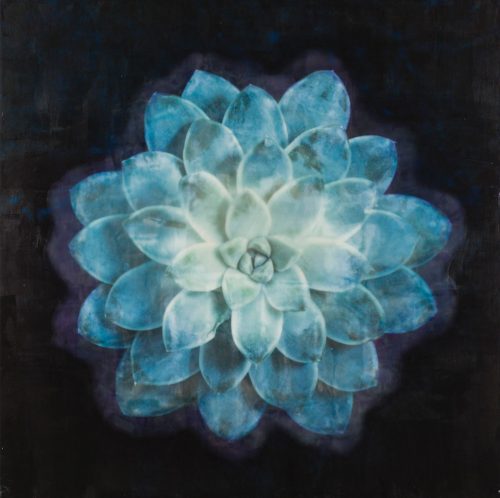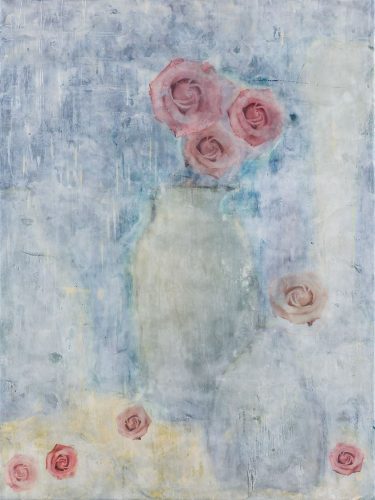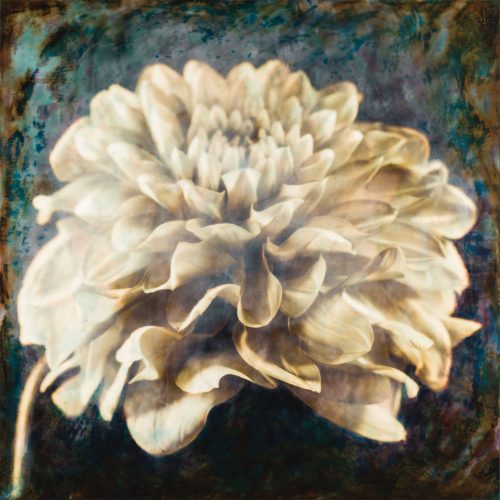
Deborah Whitlaw Llewellyn first photographs the flowers, alters the images in Photoshop, and then applies cutouts of the printed images between layers of pigmented wax.
After working as an interiors, lifestyle, and food photographer for more than two decades, Deborah Whitlaw Llewellyn has honed a keen eye for detail. Whether shooting in someone’s home, working with a model, or capturing the grains in a single spoonful of sugar, she knows it’s the little things that make the biggest difference when framing the perfect shot. Scale and balance are key, the light has to be just right, and the model has to look just so. Sometimes a single image is the result of a momentous team effort requiring lots of planning and hours.
Ochre and brown pigments mix with wax to give a sepia tone to a scattering of succulents (Amber Fall, 43″ x 38″).
When Llewellyn turns her focus to her photographic encaustic art, it’s a singular pursuit. Finding serenity in her studio at The Goat Farm Arts Center in Atlanta, Llewellyn’s best company is her favorite subject: flowers. It’s an escape from the fast pace of commercial photography. “Flowers don’t have any requirements,” she says. “You don’t have to book a model; you don’t have to wait for the light.”

After photo- graphing a ower, Llewellyn transfers the image or images to a ber-based paper with sandpaper, wax, and a spoon, then a xes the print to a wood panel (Smoke and Wax, 43″ x 38″).
She begins each painting by hand-selecting fresh flowers. From there, she photographs them, capturing shape, shadow, and detail before manipulating the color and crop in Photoshop. She then either transfers the image directly onto a layer of wax from a laser print and covers with more wax, or has the image printed onto extra-large, archival, fiber-based paper and adheres it to a wood panel. She then starts the encaustic painting process. “Encaustics are heavy; you need to have a wood base to support the weight of the wax and to keep it from cracking,” she says.

A Polaroid transfer was the beginning of this pastel-hued piece (Pastoral, 40″ x 30″)
Once the image is in place, Llewellyn applies coats of beeswax, damar resin, oil paints, and cold wax to create depth and transparency. “Each layer has to dry before applying the next,” she says. “Sometimes there may be
20 coats of wax and paint on one piece.” Llewellyn likens her work to the crumbling layers of paint and plaster on an ancient wall of a Tuscan villa. “When looking at one of my paintings in reverse, I like to imagine someone discovering the history and patina under each layer,” she says of the marks, brushstrokes, lines, words, and colors embedded throughout.

The curls, folds, and shadows in the dahlia petals are enhanced layers of pigment, wax, and varnish (Pearl, 47″ x 47″).
Creating layers of intrigue requires many steps, a lot of materials, and a lot of time. Aside from her camera, her tool kit consists of an assortment of skillets and griddle pans for melting wax, a blowtorch, razor blades, paint scrapers, paint, and brushes. “It’s also physically intensive,” Llewellyn says.
Requiring patience, technique, and creativity, the process demands focus yet allows for spontaneity. “Sometimes you may be working on two, three, or four paintings at the same time because you have to allow for drying time. But you also have to move quickly before the wax completely hardens.”

Artist Deborah Whitlaw Llewellyn in her studio
Encaustic painting has been around since ancient Egyptian times, but Llewellyn just started it six years ago. “I worked with Brooklyn artist Michael David to learn the technique,” she says. “He does big, funky, chunky stuff, but you have to find your own style and subject matter.” For Llewellyn, that means flowers and pleasing color schemes that would look good in any of the interiors that she photographs. “I’m not political, and I’m not trying to send a big message,” she says. “Flowers are just pretty and peaceful.”
Llewellyn is represented by DK Gallery.
By Cathy Still McGowin | Photography by Deborah Whitlaw Llewellyn



